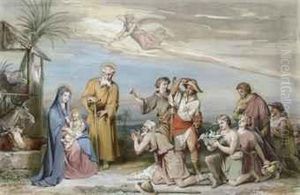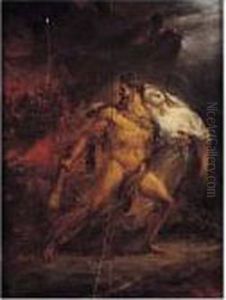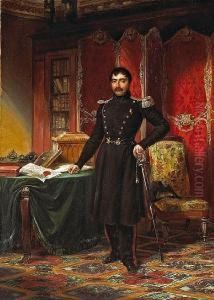L. Charles Auguste Couder Paintings
L. Charles Auguste Couder, born Louis-Charles-Auguste Couder in Paris on April 1, 1790, was a distinguished French painter and lithographer known for his historical scenes, portraits, and Orientalist subjects. Couder's career spanned much of the 19th century, a period marked by significant political upheaval and cultural shifts in France and Europe at large.
Educated at the École des Beaux-Arts in Paris, Couder was a student of notable artists such as Jacques-Louis David. He quickly made a name for himself in the Parisian art scene, exhibiting at the prestigious Paris Salon for the first time in 1812. His works from this period reflect the Neoclassical style, which was prevalent in French art at the time, characterized by its emphasis on clarity, order, and symmetry.
Throughout his career, Couder embraced a variety of subjects, demonstrating his versatility as an artist. He is perhaps best known for his historical paintings, which often depicted pivotal moments from French and European history with dramatic flair and attention to detail. One of his most celebrated works is 'The Siege of Yorktown', a grand depiction of the decisive American victory during the American Revolutionary War. This painting, along with others by Couder, can be seen in the prestigious galleries of the Palace of Versailles, highlighting his contribution to French historical narrative through art.
In addition to his historical works, Couder also gained recognition for his Orientalist paintings. These works, inspired by his travels in the Middle East and North Africa, captured the imagination of a French public fascinated by exotic lands beyond Europe. Couder's Orientalist paintings are notable for their vibrant color palette and the intricate detailing of scenes from daily life and landscapes in the regions he visited.
Couder's talents were not limited to painting; he was also an accomplished lithographer, contributing to the popularization of lithography in France. His lithographs, often based on his paintings, were widely circulated, further enhancing his reputation and influence.
Despite his success, Couder's work fell into relative obscurity after his death in Paris on July 21, 1873. However, in recent years, there has been a renewed interest in his oeuvre, with art historians and collectors recognizing the richness and diversity of his contributions to 19th-century French art. Today, Couder's works are held in high esteem, not only for their aesthetic qualities but also for their historical significance, offering insights into the cultural and political landscapes of his time.
















